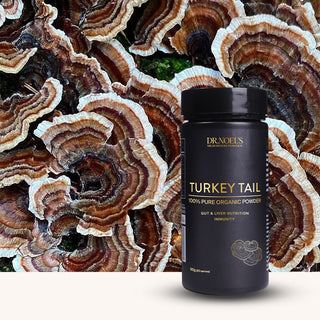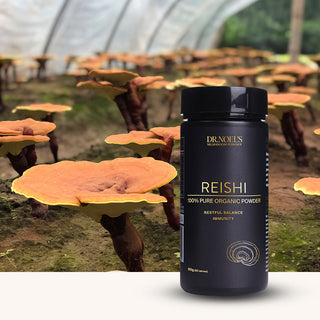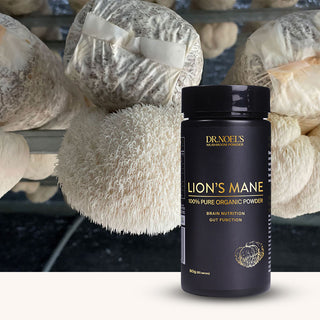Meta description: Edible mushrooms are low-energy, nutrient-dense foods packed with β-glucans, terpenes and polyphenols. Emerging human and animal studies suggest they can help with weight control and metabolic health by modulating glucose and lipid metabolism, calming inflammation and reshaping the gut microbiome.
-
Mushrooms are naturally low in kilojoules, high in fibre and rich in bioactives (β-glucans, terpenes, polyphenols, ergosterol/Vitamin D₂).
-
Clinical and preclinical studies indicate benefits for weight, waist circumference, blood lipids, glucose control and inflammation—especially when mushrooms replace higher-energy foods like red meat.
-
Mechanisms include slower carbohydrate absorption, improved insulin signalling, reduced lipogenesis, enhanced fat oxidation, antioxidant and anti-inflammatory effects, and prebiotic actions that boost short-chain fatty acids (SCFAs).
-
Evidence is promising but still early: many trials are small, short, or use different species and extracts. Larger, longer studies are needed.
Why Mushrooms Deserve a Place in Weight-Focused Diets
Edible mushrooms have long been part of global cuisines for their flavour and culinary versatility. Nutritionally, they punch well above their weight: compared with most vegetables, dried mushrooms contain significantly more protein (including all nine essential amino acids), are low in fat and carbohydrate, and deliver meaningful amounts of B-vitamins (B2, B3, folate), minerals (potassium, phosphorus, magnesium, selenium, iron and zinc), and a variety of bioactive compounds.
Fresh mushrooms typically provide ~20–30 kcal (≈84–126 kJ) per 100 g—far less than cereals or meat—while their fibre (notably β-glucans) enhances fullness and slows gastric emptying. Mushrooms are also one of the best natural sources of ergosterol, which converts to vitamin D₂ under UV light—helpful because vitamin D deficiency is common in people with obesity and is linked to reduced insulin sensitivity and low-grade inflammation.
Key bioactives include:
-
Polysaccharides (especially β-glucans): immune-modulating, antioxidant, anti-inflammatory, prebiotic.
-
Polyphenols (e.g., gallic acid, p-hydroxybenzoic acid): strong antioxidant/anti-inflammatory activity.
-
Terpenes/terpenoids (notably triterpenes in Ganoderma lucidum/reishi): anti-inflammatory and lipid-modulating effects.
-
Other constituents (alkaloids, lectins) may further influence lipid metabolism, immune tone and gut function.
What Evidence Do We Have for Anti-Obesity Effects?
Human studies
-
Food swap approach: In a 12-month, calorie-restricted trial, adults who replaced part of their red meat intake with button mushrooms achieved greater weight loss, larger reductions in waist circumference and body fat percentage, and better maintenance at 6–12 months than the meat-based control diet. Markers like triglycerides, fasting glucose and hs-CRP also improved in the mushroom group.
-
Single-meal/short-term studies: When a mushroom-based lunch replaced an energy-dense meat lunch, participants consumed far fewer kilocalories at that meal and across the day—without reductions in palatability or fullness—suggesting a practical, sustainable substitution strategy.
Metabolic outcomes beyond weight
-
Blood pressure: Small trials and mechanistic studies indicate peptides from several species can inhibit angiotensin-converting enzyme (ACE), nudging blood pressure down in hypertensive adults.
-
Glucose control: Randomised work with Agaricus blazei extracts and dietary powders from Pleurotus species report improved insulin sensitivity, higher adiponectin and lower post-prandial glucose.
-
Lipids: Powders and polysaccharides from button mushrooms and wood ear (Auricularia auricula) lowered total cholesterol and triglycerides in animal models; long-term Pleurotus intake in humans has been associated with reductions in fasting glucose, total and LDL-cholesterol, and blood pressure—without liver, kidney or haematological harm signals.
-
Oxidative stress & inflammation: Daily button mushroom intake increased circulating ergothioneine (a dietary antioxidant), improved antioxidant capacity (e.g., ORAC) and adiponectin, and reduced glycation/oxidative stress markers.
Bottom line: When mushrooms displace higher-energy foods (especially fatty meats) in a calorie-aware diet, people tend to eat less energy overall while maintaining satisfaction—helping with weight control and improving several metabolic markers.
How Do Mushrooms Work? Four Core Mechanisms
1) Restoring Glucose Homeostasis
-
Slower carb absorption: β-glucans increase chyme viscosity and can inhibit α-amylase/α-glucosidase, blunting post-meal glucose spikes.
-
Better insulin signalling: Polysaccharides activate PI3K/AKT pathways, remove the ‘brake’ on glycogen synthesis, and support GLUT-4 translocation—improving peripheral glucose uptake.
-
Vitamin D₂ link: Ergosterol-derived D₂ and its active form influence calcium signalling and gene expression via VDR/RXR, potentially reducing insulin resistance and inflammatory stress on β-cells.
2) Rebalancing Lipid Metabolism
-
Less fat making, more fat burning: Extracts down-regulate SREBP-1-driven lipogenesis (FAS, ACC, ELOVL6) and up-regulate PPAR-α targets that promote fatty-acid β-oxidation and cholesterol-to–bile acid conversion.
-
Hepatic cholesterol handling: Polysaccharides enhance CYP7A1 and bile salt export, increasing faecal bile acids and lowering serum TC/LDL-C.
-
Direct effects on fat cells: Ergosterol peroxides and related compounds suppress adipogenesis by reducing PPAR-γ/SREBP-1c signalling and MAPK/ERK activation—limiting triglyceride accumulation at the cellular level.
3) Antioxidant and Anti-inflammatory Actions
-
Free-radical defence: Mushroom polyphenols and polysaccharides quench ROS directly and via the KEAP1-Nrf2-ARE axis, boosting SOD, CAT and GPx activity.
-
Inflammation dial-down: β-glucans and triterpenes inhibit NF-κB and AP-1 pathways, lowering TNF-α, IL-6, COX-2 and iNOS—protecting pancreatic β-cells and adipose tissue from lipotoxic/oxidative damage.
-
Micronutrient support: B-vitamins, selenium and vitamin D₂ further support antioxidant enzymes and immune balance.
4) Reshaping the Gut Microbiome (and SCFAs)
-
Prebiotic fibres: Mushroom β-glucans, chitin, hemicelluloses and mannans resist human digestion but feed beneficial microbes (e.g., Bifidobacterium, Lactobacillus, Akkermansia), while reducing LPS-producing taxa.
-
Barrier integrity: High-molecular-weight polysaccharides help repair tight junctions and reduce metabolic endotoxaemia.
-
SCFA production: Different species foster distinct SCFA profiles (acetate, propionate, butyrate). SCFAs fuel colonocytes, curb appetite (via GLP-1 and PYY), and influence energy expenditure and insulin sensitivity. Species matter—the Pleurotus genus often shows robust, broad SCFA increases, while others may skew the acetate:propionate:butyrate ratio differently.
Important Caveats
-
Many clinical trials are single-centre with modest sample sizes and varied durations.
-
Interventions differ widely (whole foods vs dried powders vs crude extracts vs purified polysaccharides/triterpenes), making head-to-head comparisons tricky.
-
Few studies directly compare mushroom-forward diets with established weight-loss diets (e.g., low-fat, low-carb, Mediterranean).
-
Dose–response and species-specific effects (including SCFA profiles) need clearer mapping.
Practical Ways to Use Mushrooms for Weight & Metabolic Health
-
Swap, don’t just add: Replace some red or processed meat at lunch or dinner with a hearty mushroom serve (e.g., 150–250 g cooked).
-
Mix your species: Combine button/portobello with oyster, enoki, shiitake or king oyster to diversify fibres and bioactives.
-
Leverage fibre: Include mushrooms in soups, stews, grain bowls or stir-fries to raise volume and satiety for fewer kilojoules.
-
Consider vitamin D₂: UV-exposed mushrooms can boost vitamin D intake—useful where deficiency is common.
-
Supplements? Extracts (e.g., β-glucans, reishi triterpenes) are being studied, but whole-food strategies remain the safest foundation. If using supplements, choose products with transparent COAs and clinically relevant dosing, and speak with your healthcare professional—especially if you take antihypertensives, anticoagulants or diabetes medications.
Outlook
The case for mushrooms as a weight-management ally is compelling: low energy density, strong satiety, and multi-target bioactivity spanning glucose and lipid metabolism, oxidative stress, inflammation and the gut microbiome. What we need next are larger, multi-centre, long-term randomised trials that compare mushroom-rich patterns against gold-standard weight-loss diets, map species-specific SCFA fingerprints, and clarify optimal doses and formats (whole food vs specific extracts).
Take-home: Incorporating a variety of mushrooms as regular meat substitutes within a balanced, calorie-aware diet is a practical, evidence-aligned strategy to support weight control and healthier metabolic markers—today, not just in theory.





